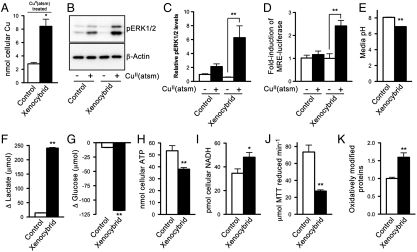Fig. 3.
Effects of a genetically impaired mitochondrial electron transport chain on energy metabolism and cellular responses to CuII(atsm). (A) ICP-MS analysis of cellular Cu in control cells and xenocybrid cells after treating with 10 μM CuII(atsm) for 1 h. (B) Western blotting image showing CuII(atsm) promotes phosphorylation of ERK1/2 (pERK1/2) in xenocybrid cells. β-Actin levels are shown as a control. (C) Densitometry analysis of Western blotting results. (D) Before treating with 500 nM CuII(atsm) for 6 h, cells were transfected with MRE-luciferase construct. Treatment-induced increases in bioavailable Cu within the cell upregulates expression of the luciferase reporter, induction of which is measured by luminescence. (E) pH of media collected from cells after 6 d in culture. (F) Lactate produced and (G) glucose consumed by cells over 6 d in culture. (H) ATP and (I) NADH content of control cells and xenocybrid cells. (J) Reduction of MTT mediated by cell lysates collected from control cells and xenocybrid cells. (K) Relative content of oxidatively modified proteins in control cells and xenocybrid cells. Data are mean values ± SEM, n = 3–6. Values in A and E–J are expressed per milligram cellular protein. ∗P < 0.05/∗∗P < 0.01 compared to control cells (t test) except for C and D where *P < 0.01 compared to vehicle-treated cells (ANOVA with Tukey’s posttest).

